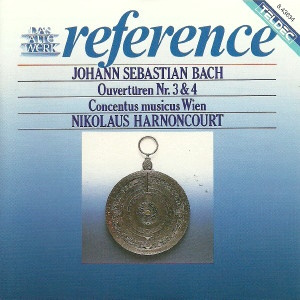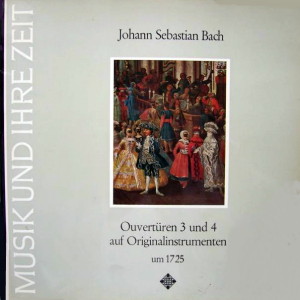 |
| 1 CD -
8.43634 ZS - (c) 1987 |
 |
1 LP -
SAWT 9510-A - (p) 1967
|
|
OUVERTÜREN Nr. 3 & 4 - um 1725
|
|
|
|
|
|
|
|
|
|
| Johann Sebastian BACH
(1685-1750) |
Ouvertüre
(Suite) Nr. 3 D-dur, BWV
1068 |
|
24' 40" |
|
A |
|
für
Tromba (Carintrompete) I, II, III;
Timpani (Barockpauken); Oboe I, II;
Fagott; Violine I, II; Viola; Continuo
(Violoncello, Violone [Kontrabaß],
Cembalo) |
|
|
|
|
|
- Ouverture |
11' 59" |
|
1 |
|
|
- Air |
4' 31" |
|
2 |
|
|
- Gavotte
I alternativement / Gavotte II |
3' 56" |
|
3 |
|
|
- Bourrée
|
1' 24" |
|
4 |
|
|
- Gigue |
2' 50" |
|
5 |
|
| Johann Sebastian BACH |
Ouvertüre
(Suite) Nr. 4 D-dur, BWV
1069 |
|
23' 46" |
|
B |
|
für
Tromba (Carintrompete) I, II, III;
Timpani (Barockpauken); Oboe I, II, III;
Fagott; Violine I, II; Viola; Continuo
(Violoncello, Violone [Kontrabaß],
Cembalo) |
|
|
|
|
|
- Ouverture |
12' 22" |
|
6 |
|
|
- Bourrée I
alternativement / Bourrée II
|
2' 32" |
|
7 |
|
|
- Gavotte |
1' 52" |
|
8 |
|
|
-
Menuet I
alternativement / Menuet II
|
4' 25" |
|
9 |
|
|
- Réjouissance |
2' 55" |
|
10 |
|
|
|
|
|
|
CONCENTUS
MUSICUS WIEN (mit
Originalinstrumenten)
- Josef Spindler, Clarintrompete in D
- Hermann Schober, Clarintrompete in D
- Richard Rudolf, Clarintrompete in D
- Kurt Hammer, Barockpauken
- Jürg Schaeftlein, Barockoboe
- Bernhard Klebel, Barockoboe
- Karl Gruber, Barockoboe
- Otto Fleischmann, Barockfagott
- Alice Harnoncourt, Violine
-
Peter Schoberwalter, Violine
-
Stefan Plott, Violine
-
Walter Pfeiffer, Violine
-
Josef de Sordi, Violine
-
Kurt Theiner, Viola
-
Nikolaus Harnoncort, Violoncello
- Eduard
Hruza, Violone
- Herbert
Tachezi, Cembalo
Nikolaus
HARNONCOURT, Leitung |
|
|
|
|
|
Luogo
e data di registrazione |
|
Casino
Zögernitz, Vienna (Austria) -
December 1966
|
|
|
Registrazione:
live / studio |
|
studio |
|
|
Producer |
|
Wolf
Erichson
|
|
|
Prima Edizione
LP |
|
Telefunken
- SAWT 9510-A - (1 LP) - durata
48' 26" - (p) 1967 - Analogico
|
|
|
Edizione
"Reference" CD
|
|
Tedec
- 8.43633 ZS - (1 CD) - LC 3706 -
durata 48' 26" - (c) 1987 - AAD |
|
|
Cover |
|
Foto mit
freundlicher Genehmigung des
Museums für Kunst und Gewerbe
Hamburg |
|
|
Note |
|
-
|
|
|
|
|
The
form of the suite
ensures the
greotest possible
freedom for the
composer. ln many
suites of that
period, however,
with their loose
linking of the
movements to one
onother, this led
to a certain
formlessness of
the work os a
whole. That such a
form creator as
Bach, who fitted
every work into a
strict self-mode
orchitectural plan
in which the
overall structure
ond the smallest
musicol gesture
alike had their
place, had to
regord this
"unformed" form os
a challenge and
stimulus is
self-understood.
The selection and
sequence of the
movements as a
task for the
performera a
matter of course
in Fronce ten yeas
earlier and still
quite thinkable
among his
contemporaries, is
out of the
question in this
suites. One cannot
amit a single
movement or put it
in a different
place, without
destroying the
whole work. For
Bach differed in
one importont
respect from all
composers of his
generotion: he
rejected the
freedom of the
performer, that
essentiol feature
of all boroque
music, entirely.
Perhaps it was
just because he,
as an unequalled
improviser, knew
the dangers that
threatened the
best compositions
of his colleagues
through the
arbitrary
interference
self-understood at
that time, such as
choice of
instruments,
transposition,
arrangements of
the order or again
through clumsy
ornamentation,
that he left no
place for this in
his own works. ln
this, he was two
generations ahead
of his time. Just
as he wrote out
the execution of
the ornaments in
detail - which
must almost have
been on insult to
the musicians of
that time - he
also laid down
himself the final
and unequivocal
form.
Through
the extension of
the dominating
introductory
movement, the
overture, to half
the length of the
entire work, he
elevated his
suites from the
sphere of light
"table music" and
formed them into
genuine works of
"worldly" festive
music. The
elements of
greatness and
splendour are
underlined by the
constitution of
the orchestra in
the 1st 3rd and
4th suites. The
dances and
characteristic
pieces follow the
overture according
to a brilliant
plan of dramatic
significance.
The
structure of the
Third Suite in D
major is more
easily grasped
than that of the
other suites,
alone on account
of the smaller
number of
movements. After
the magnificently
energetic overture
there follows, as
the heart of the
work, the unique
Air. lt is an
"italian" adagio
which Bach has
placed as the only
movement
reminiscent of the
Vivaldi style in
the “French”
environment. This
stylistic contrast
lends its
far-soaring melody
an added magic.
The three French
dance movements
that follow again
offer an ingenious
intensification of
tempo and
expression; from
the aristocratic
Gavotte there
springs, as it
were, the fiery
Bourrée, and the
work then closes
with a further
intensification in
the energetic
Gigue. ln this
Gigue, the ltalian
and French forms
of the dance, of
explained above,
are blended in a
wonderful manner.
The 1st violins
and the oboes run
along in quavers,
it is true. but
since these are
not led in
virtuoso leaps and
broken chords as
in the ltalian
gigue but in small
intervals -
furthermore being
slurred in
half-bars - the
soloist bravura
characteristic of
the Italian gigue
is tamed to
produce a finale
with wide melodic
curves in the
upper part rising
above the
dance-like,
forwardurging
foundation of the
middle parts and
the bass.
The
Fourth Suite in D
major is the only
one already to
include an allegro
section in dance
character in the
overture. The
character and
rhythm of a gigue
are built into the
form of the fugato
Allegro. The
sequence of dances
is not laid out so
as to create an
intensification
here, but as a
continual calming
down. lt begins
with a passionate
Bourrée; the
Govotte that
follows is both
one degree more
moderate in tempo
and one stage more
noble in
character. ln the
Minuet, which is
still more calm in
tempo, courtly
elegance and
restraint dominate
again. The
sequence of these
three movements
thus shows not
only a calming of
the passion, o
moderating of the
tempo, but more
still a gradual
becoming nobler
expressed in ever
greater
self-control. The
Réjouissance is
here simply the
necessary joyful
finale, intended
to dismiss the
listener gaily
after the suite.
Concertante
Elements in the
Suites
Soloists are already
used un the earliest
overtures and dances
of Lully, preference
being shown for a
trio of two oboes
ond a bossoon that
reply to the tutti
sections played
"forte". The
contrasting of two
dances played in
alternation (such as
two minuets or two
govottes), the
second of which was
allated only to this
solo trio (thus the
later classical
designation "Trio"
for every second
minuet) was also
introduced by Lully.
These solo
possibilities
already prepared
were extended by
Bach in many
directions. There
are predominant solo
instruments in each
of his suites, which
make their main
appearance in the
Allegro section of
the overture thus
lending it a
concertante
character buth are
also heard in the
dances. In the First
Suite it is the two
oboes and the
bossoon, whose
virtuoso passages
even go beyond those
of the First
Brandenburg Concerto
in their technical
demands Their solos
are explicitly
headed "Trio" in the
autograph wind parts
The bassoon, in
particular, was
otherwise given such
difficult and solo
tasks only by
Vivaldi at that
time. Also
concertante are -
apart from the
Overture - Gavotte
ll and Passepied ll,
whereas the Bourrée
II is a genuine wind
trio in the older
sense. ln the Second
Suite the transverse
flute predominates,
which had just risen
to the status of o
highly fashionable
instrument at that
time. "...This
instrument it is
true, has become
very popular,
especially in
Germany, since
thirty to forty
years...", writes
Quantz in 1752. It
here plays solo in
the Overture.
Randeau (Govotte),
Baurrée Il, in the
Double of the
Polonoise and in the
Badinerie.
Nikolaus
Harnoncourt
|
|